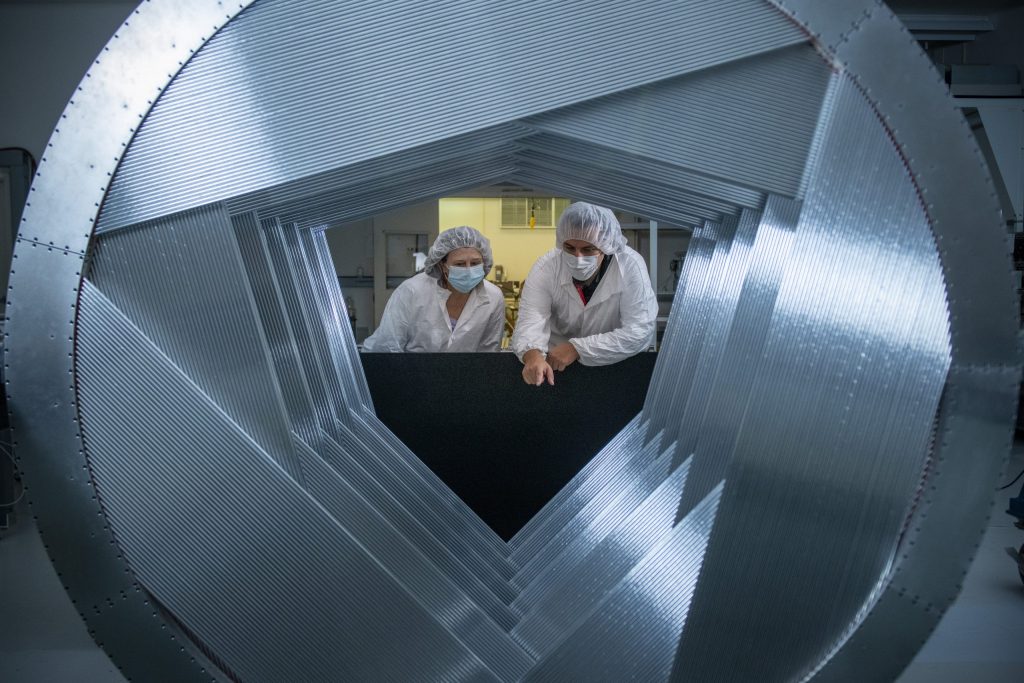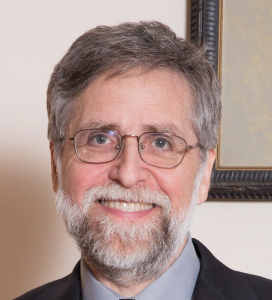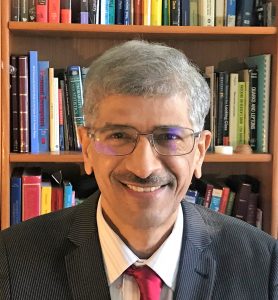Scientists build complex machines to better understand the particles that make up our universe — and sometimes, they use materials you might not expect. One example? The upcoming Mu2e experiment at the U.S. Department of Energy’s Fermi National Accelerator Laboratory will incorporate thousands of straws made by a drinking straw company.
But these aren’t your average soda straws. Mu2e will use special mylar straws, with walls thinner than a human hair, to search for a never-before-seen transformation of subatomic particles called muons.
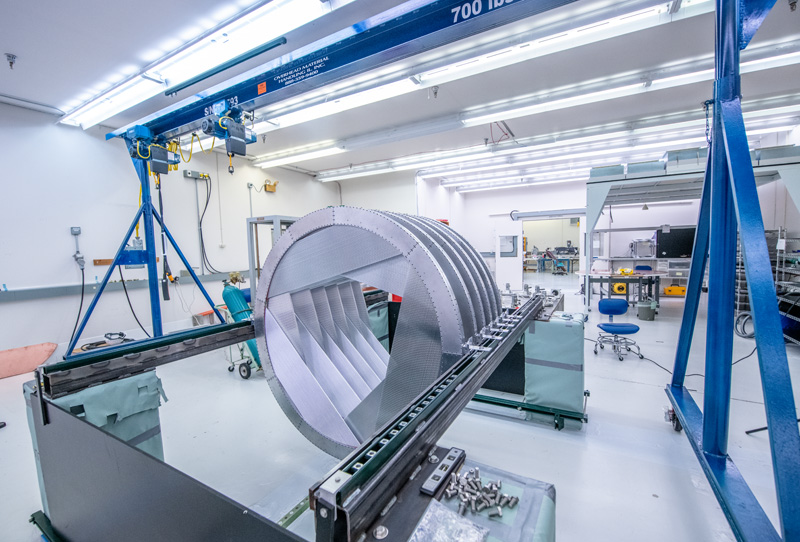
Several of the Mu2e tracker planes, featuring thin mylar straws, are assembled in a cleanroom at Fermilab. The full tracker will contain 21,600 straws to measure the paths, energies and momentums of electrons with high precision. Photo: Ryan Postel, Fermilab
Teams from this international collaboration are currently constructing the Mu2e particle detector at Fermilab and aim to start taking physics data by 2026. If they find the rare, sought-after signal, it will be a sign of new physics beyond the tried and tested Standard Model of particle physics. It would help pave the way to answering open questions about the fundamental nature of elementary particles and forces that physicists have had for many years.
“All of our measurements come up for what seems like a zillion decimal points right on target with the Standard Model,” said Karen Byrum, a scientist at Argonne National Laboratory and the electronics integration team leader for Mu2e. “But we know there’s stuff out there we can’t explain, like results from the Muon g-2 experiment at Fermilab and the LHCb experiment at CERN.”
A clue may lie in one peculiar family of particles.
From muon to electron
Particles come in different categories. Perhaps the most familiar are the leptons, whose smallest member, the electron, swirls around in atoms and powers electronic devices.
Charged leptons come in three types that all behave similarly but have different masses: the electron, muon and tau. Why there are these three types of particles is one of the big open questions in particle physics. While the electron is well studied, its 200-times heavier cousin, the muon, holds many mysteries that could help scientists understand fundamental aspects of matter.

Eleonora Diociaiuti and Stefano Miscetti examine one of the 1,348 cesium iodide crystals that will be installed in the Mu2e calorimeter. It will measure the energy of electrons emerging from muon decays with high precision. Photo: Ryan Postel, Fermilab
There are also three flavors of electrically neutral leptons called neutrinos: electron neutrinos, muon neutrinos and tau neutrinos. Scientists have spotted neutrinos changing directly from one type into another. So follows a natural question: Can the charged members of the lepton family shapeshift in the same way?
Mu2e (pronounced mew-to-e) will try to find out by searching for a muon changing directly into an electron without emitting any other particles, the muon-to-electron conversion that gives the experiment its name. Such a transformation would have a distinct signature that an extremely precise detector could see. But it has never been observed so far. The 200-plus Mu2e collaborators from 38 institutions in 6 countries aim to change that.
“I am looking forward to the physics run and the breakthrough physics that is Mu2e. It has the potential to open new doors to highly sought after problems of the Standard Model, like lepton hierarchy, neutrino masses and even dark matter.” — Mete Yucel, Fermilab
An electron in a haystack
Researchers expect that, if the muon-to-electron phenomenon occurs, it will happen extremely rarely — less often than once in every 1,000 billion muons. The Mu2e experiment will thus need to create and sift through an incredible number of particles.
The experiment will create a beam of 10 billion muons per second that travel toward an aluminum target. Aluminum nuclei will capture the muons, pulling them into orbit as though they were electrons in a standard atom. Once the muons are trapped around the nuclei of the aluminum atoms, researchers can look for the transformation.
If a muon decays normally, into an electron and two neutrinos, all three particles will carry away some of the energy. But if a muon transforms only into an electron, the electron will emerge with all of the muon’s energy: 105 MeV, or megaelectronvolts. This is the distinct signature that will tell physicists they’ve found something new.
“It’s not a signal where you’re going to have thousands of events; it’s going to be a handful,” Byrum said. “You have to understand your detector and the backgrounds that can mimic your signal.”
Measuring with extreme precision the energy of each electron observed is crucial to eliminating particle events that could create a false signal.
Building a precision detector
Capturing and distinguishing precise amounts of energy from billions of electrons takes a powerful detector. Mu2e experimenters are currently building two of the primary components for the detector that will live inside the experiment’s magnet: the tracker and the calorimeter.
The tracker will measure the paths, energies and momenta of the electrons, using 21,600 mylar straws specially made by the drinking straw company using a modified winding technique. Once laser-cut to length, the straws were arranged in a series of 36 circular planes, each one nearly as tall as a person. Every slender straw contains a gold-plated tungsten wire to collect and transmit information as electrons pass through.
“It is incredibly challenging to build such a big, precise and delicate device,” said Mete Yucel, a Fermilab scientist leading the plane assembly for the tracker. The equipment is built through collaboration with several universities and Berkeley Lab and is currently under construction at Fermilab. The tracker should be complete in 2024, though one of the planes has already been running for more than a year. Using this “Vertical Slice Test Plane,” researchers have reconstructed tracks from muons produced in the atmosphere and tested some of the software and algorithms Mu2e will use.
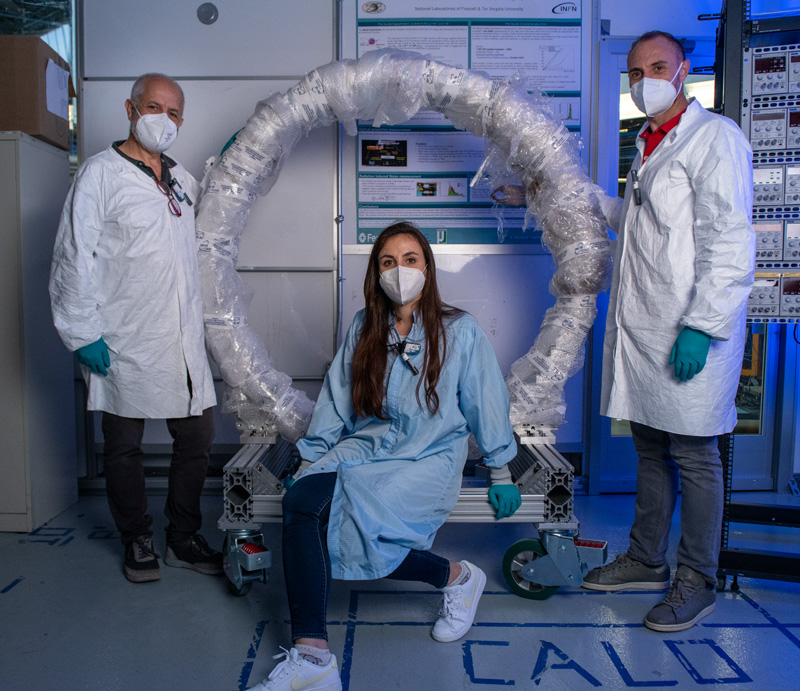
From left to right: Stefano Miscetti, Eleonora Diociaiuti and Ivano Sarra pose with the protected calorimeter skeleton. Photo: Ryan Postel, Fermilab
Despite the tracker’s precision, measuring the energy from the electrons requires more information, which is where the calorimeter comes in.
Over the last few months, the Mu2e team has finished assembling the calorimeter’s skeleton: two one-ton disks, each with slots to contain 674 pure cesium iodide crystals that will be installed this summer. When an electron hits a crystal, it creates a shower and emits photons. Custom-built light detectors capture the information and tell scientists how much energy was deposited.
“When an electron arrives in the tracker, it moves in the magnetic field almost unmodified. When it arrives at the calorimeter, it’s absorbed,” said Stefano Miscetti, a scientist from the Italian National Institute of Nuclear Physics who is leading the calorimeter construction. “We can measure the timing at which the particle arrives very, very precisely. The calorimeter team is very eager to see the startup of this very exciting and challenging experiment.”
Researchers have successfully tested and measured the calorimeter’s timing to within 100 picoseconds, or 100 trillionths of a second. By combining data from the tracker and calorimeter, scientists will have more than enough data points to know if they’re seeing something spectacular.
While work on the detector continues, collaborators are making progress on the rest of experiment. The first section, where the muons will be produced, is nearly complete. Over the past year, researchers have also tested the magnets that will make up the middle section known as the transport solenoid, which will guide the muons to the aluminum target. Lastly, work is ongoing on the cosmic ray veto system, the third essential detector component that will sit outside the magnet and catch any false signals created by muons from space.
When the Mu2e experiment comes online, it will be 10,000 times more sensitive than any other experiment that has looked for the muon-to-electron conversion. Scientists expect to begin installation and commissioning of the experiment in 2024 and to be ready to take data in 2026.
“It has the potential to open new doors to highly sought-after problems of the Standard Model, like lepton hierarchy, neutrino masses and even dark matter,” Yucel said. “I am looking forward to the physics run and the breakthrough physics that is Mu2e.”
Fermi National Accelerator Laboratory is supported by the Office of Science of the U.S. Department of Energy. The Office of Science is the single largest supporter of basic research in the physical sciences in the United States and is working to address some of the most pressing challenges of our time. For more information, please visit science.energy.gov.
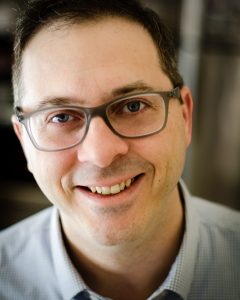
Fermilab scientist Matt Toups will serve as co-spokesperson for the MicroBooNE experiment as it continues to investigate particles called neutrinos. Photo: Renee Toups
The MicroBooNE neutrino experiment is entering a new phase of life. With data collection recently completed, the collaboration is now focused on analysis, peering into six years’ worth of data to better understand neutrinos. As of Feb. 7, 2022, the collaboration also has new leadership. Matt Toups, a scientist at the U.S. Department of Energy’s Fermi National Accelerator Laboratory, was elected co-spokesperson. He joined Justin Evans of the University of Manchester in leading the experiment.
“We’re entering this phase in the collaboration where we’re hitting our stride in terms of reconstructing the data, making sense out of it and putting out premiere physics results that the community can really sink their teeth into,” said Toups. “I think it’s our golden era of physics results.”
Toups earned his doctorate from Columbia University, focusing on the behavior of neutrinos from nuclear reactors in the Double Chooz experiment for his thesis. He began working on MicroBooNE electronics in 2012 as a postdoctoral researcher at MIT and then co-led commissioning of the MicroBooNE detector. Toups has served as physics analysis coordinator since the experiment came online in 2015. He currently also works on the Short-Baseline Near Detector and Deep Underground Neutrino Experiment, international projects hosted by Fermilab that will build off of MicroBooNE’s discoveries and expertise in liquid-argon detector technology.
“Matt has an incredible wealth of experience in MicroBooNE — in how the detector works, in the physics that we are doing, and in working with the world-class people who make up our collaboration,” Evans said. “He has provided leadership for many years and was central to the first searches for a low-energy excess that we recently published. I am delighted to be working with him now as co-spokesperson, and we have an exciting time ahead of us.”
MicroBooNE is a 170-ton neutrino detector about the size of an American school bus, and one of three experiments in Fermilab’s short-baseline (or short-distance) neutrino program. MicroBooNE’s cutting-edge technology can record incredibly precise 3D images of neutrino events, providing detailed information about how these elusive particles interact. Almost 200 collaborators from 37 institutions in five countries work on the experiment.
Using about half of their data, collaborators released their first flagship neutrino results in fall 2021. The exciting result all but ruled out two of the most likely causes for an experimental anomaly that has remained unexplained for two decades. As researchers continue to analyze their data, they’ll turn to different and sometimes more exotic options, including physics that lies beyond the current best theory: the Standard Model.
MicroBooNE’s cutting-edge technology can record incredibly precise 3D images of neutrino events, providing detailed information about how these elusive particles interact.
“There’s a lot of interesting physics topics to explore,” Toups said, noting that in recent workshops, MicroBooNE researchers collaborated with theorists on possible explanations for their data and generated new ideas for physics analyses. “It’s great to see the creativity of the collaboration coming through with new ideas, and it’s exciting because they’re things our detector is capable of probing.”
In addition to physics analysis, the MicroBooNE team will also be working on how best to integrate the knowledge and tools developed for their experiment into the neutrino detectors coming online over the next few years. Together, the suite of experiments will better understand one of the strangest particles and the fundamental nature of our universe.
“We’re seeing the power of liquid-argon detectors to do this sophisticated physics and search for new phenomena and answer some of these lingering questions,” Toups said. “It’s exhilarating.”
Fermi National Accelerator Laboratory is supported by the Office of Science of the U.S. Department of Energy. The Office of Science is the single largest supporter of basic research in the physical sciences in the United States and is working to address some of the most pressing challenges of our time. For more information, please visit science.energy.gov.
How long have you been at the U.S. Department of Energy’s Fermi National Accelerator Laboratory?
I have been with Fermilab for almost seven years. I’m still considered a newbie in the Fermilab world. I came to Fermilab from another non-profit organization. In finance and accounting, I am specifically the Fermi Research Alliance accounting manager and also currently adding sponsored programs to the mix. FRA manages Fermilab for the Department of Energy. I work on all financial aspects of FRA, the more salient areas being financial statements, reports for DOE, tax returns, budgets, reports for the board of directors and the recent addition of sponsored programs.
How did you get into accounting?
I come from a family of CPAs, so I guess it was kind of inevitable that I would end up being a CPA, working in finance and accounting. I’ve always been a math person, and math transitions well into finance and accounting. Accounting crosses all industries, and that’s the field I have been in since I graduated college.
My family emigrated from Jamaica for more opportunities when I was in my teens. I now have two college-aged daughters who are pursuing degrees that would not have necessarily been available to them there. So it warms my heart to see them pursuing avenues that were not on my radar when I was young. It means it’s the end of the CPA generation in my family, but I’m happy they can pursue what they enjoy. I hope that feeling continues for them throughout their careers, as it does for me.
I originally started out in public accounting, then transitioned to corporate accounting, and then stepped into non-profit. I do like the different types of non-profit organizations that are out there. Fermilab is considered one of the epitomes of a non-profit organization, so I was very excited to come on board here.
What does you work consist of?
For example, this week, in terms of projects, I met the deliverable for one of DOE’s annual reports earlier this week. Now I have to switch gears and start working on the two IRS tax returns that are due. Specifically, one of them literally takes months because of the input required, not only from me, but from other areas of the lab. So, although I’ll be working on those two tax returns, I also have to work on my regular, day-to-day responsibilities as they come up.
What is the most challenging part of your work?
Sometimes the challenge is that what may be a high priority for you or for me might not be a high priority for someone else — and rightfully so because they have their own responsibilities and priorities. So, at times, the challenge is working with individuals so that we can come to a common place on the timing. I have to say, most often than not, it works out well because there are really good people at Fermilab, and as you know, people make the difference in your job.
Who do you interact with the most?
I interact with a variety of people including co-workers, University of Chicago, URA, DOE representatives and board members. I don’t interact as much as I’d like to with the actual scientists and research people. But that’s OK because I know I’m here supporting them so that they don’t have to worry too much about the financial areas, which means they can concentrate on the success of their research and projects.
Do you get lots of pushback about funding?
That’s always a conversation — and that’s not different from any other company or organization out there. It’s rare that you have a company or organization that has money to blow or can spend on anything they want. So yes, there are conversations about funding, but it’s not uncommon for any type of industry to have that kind of concern.
What do you like to do in your spare time?
I like to ride my bike, and I like to travel, although, as we all know, that’s been curtailed to some degree. But I have high hopes for this spring and summer. I also like to watch tennis and listen to music, of course. Love going to live music; that’s always fun.
Which tennis tournament would you head to first?
I would pick Wimbledon because literally I’ve been trying for two years to get to Wimbledon — hotel booked, flight, everything. Last year and in 2020, I had to cancel because of COVID related issues. So I’m determined one day to do that. But I’m not snubbing my nose at any of the other majors. I would go to the Australian Open in a heartbeat or the French Open, and I’ve been to the U.S. Open a number of times.
What type of music do you love?
I’d say that I pretty much like most types of music. These days, I’m leaning more toward jazz, but I could switch to reggae in a matter of seconds. I went to a jazz club, called Winter’s, in Chicago a couple months ago. It was a quintet with saxophone. They were from the South, and I thoroughly enjoyed that; they were really good.
What’s a part of your routine you cherish?
Every morning, whether I’m at work or at home, I have to have my two large cups of hot coffee. I don’t guzzle them — they get to room temperature — so then I end up with coffee that’s not hot. Co-workers are used to seeing me go to the microwave to heat up my coffee in the mornings. I’ve been told I am a slow drinker. But no, I like to think that I savour my coffee.
Fermi National Accelerator Laboratory is supported by the Office of Science of the U.S. Department of Energy. The Office of Science is the single largest supporter of basic research in the physical sciences in the United States and is working to address some of the most pressing challenges of our time. For more information, please visit science.energy.gov.
Physics research is a global endeavor — and this year, so was the Fermilab virtual open house. More than 12,000 science fans from 35 countries tuned in as the U.S. Department of Energy’s Fermi National Accelerator Laboratory hosted its 18th Family Open House from Feb. 9-13, featuring a combination of live and on-demand content.
“This was our second year of hosting the open house virtually, and we were able to take what people were most interested in last year and translate that to this year’s program,” said Amanda Early, Fermilab senior education program leader. “We’ve built this community of people from around the world who want to hear from us, and we’re already talking about ways to incorporate some of the best virtual elements into future events.”
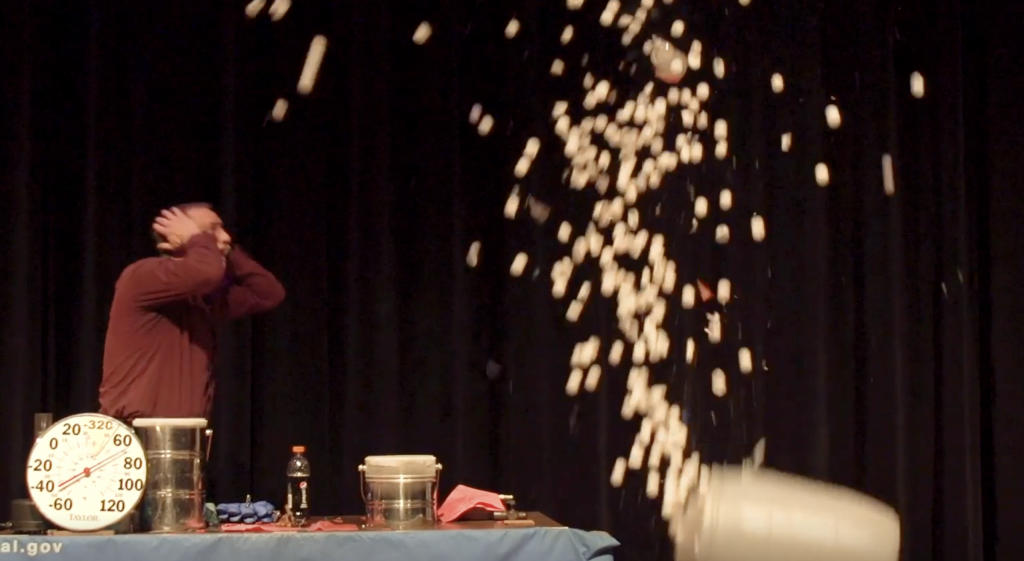
As part of this year’s Family Open House, Jerry Zimmerman, aka Mr. Freeze, conducted a live presentation that was broadcast virtually, demonstrating the coolest aspects of cryogenics. Photo: Amanda Early, Fermilab
The program aimed to bring physics from the lab to the living room and included a variety of events and activities. There were tours of the Fermilab site and of the Muon g-2 experiment, which made international headlines in 2021 when muons were found behaving in ways scientists hadn’t predicted.
“We were able to see parts of the magnet you couldn’t see even in an in-person tour,” Early said. “It gives people a different view of how complex these experiments are, and how many people have to work together to make this science happen.”
Presenters gave talks on how to build big science experiments, what the world would be like without an atmosphere, and on the intersection of art and science at the lab. For the youngest scientists, Fermilab staff read children’s books during the popular STEM story time.
Classroom presentations explored machines, energy, cosmic rays, the night sky and STEM careers. Demos were also popular: Mr. Freeze showed the coolest aspects of cryogenics; two demo makers tackled a box of mystery ingredients during the Iron Scientist competition; and high school students contributed their own demo videos as part of a virtual physics carnival.
On-demand content included a virtual tour of the quantum lab, interviews with Fermilab employees about their work, short talks in the Pecha Kucha style, and the launch of Fermilab’s bison cam.
An array of virtual events brought Fermilab physics to more than 12,000 participants in 35 countries. The 2022 Fermilab Family Open House included tours, talks, demos, classroom visits and more.
The virtual art gallery, “Be a part of pARTicles 2.0,” returned for its second year at the open house. Artists in 17 different countries took inspiration from science and created paintings, photographs, digital images, shock fossils, woodcuts, LEDs and other works. New this year was a Youth Gallery, featuring works by young artists — including an entire classroom of students in Turkey.
Many of the events and activities are still available to watch and can be accessed from the Fermilab Family Open House website or on the lab’s Office of Education and Public Engagement’s YouTube channel.
The annual open house is one of many ways that Fermilab strives to get people excited about physics. Other efforts include the Arts and Lecture Series, teacher workshops, classroom visits and educational series, such as Ask-A-Scientist and the Saturday Morning Physics — both of which have seen increased participation while virtual. The combined programs reach more than 100,000 people every year.
“Making these connections is pretty awesome, especially because you have a chance to show people there’s a place in STEM for them,” Early said, reflecting on a how a fourth-grade girl beamed when a female engineer answered her question in the Ask-An-Engineer session. “Maybe she grows up to be an engineer at the lab. You never know what kind of spark you’re going to have with somebody.”
Fermi National Accelerator Laboratory is supported by the Office of Science of the U.S. Department of Energy. The Office of Science is the single largest supporter of basic research in the physical sciences in the United States and is working to address some of the most pressing challenges of our time. For more information, please visit science.energy.gov.
In ninth grade, Patty McBride wrote a homework assignment about what she wanted to be when she grew up.
“I wanted to be a musician, set designer or nuclear physicist,” she said. “I wrote a little homework assignment about what it would be like to be a physicist.”
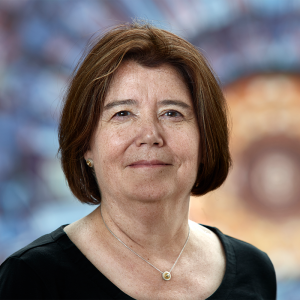
Patricia McBride. During her more than 15 years working on CMS, McBride has seen the experiment evolve far beyond its original scope. Photo: Fermilab
McBride grew up in a small town where “nuclear physicist” was an atypical career choice. She remembers the teacher commenting on her essay and saying that — while it was very well written — she was skeptical about McBride’s scientific aspirations.
McBride not only became a physicist, but she will now lead one of the largest scientific collaborations in history: the CMS experiment, which collects and studies particle collision data from the Large Hadron Collider at the international laboratory CERN.
CMS is a five-story-tall particle detector at the LHC, located just outside Geneva, Switzerland, and 300 feet underground. The international CMS collaboration comprises 3,000 scientists from more than 40 countries across the world. About a third of the scientists come from institutions in the United States. Every other year, the CMS collaboration elects a new spokesperson for a two-year term. The spokesperson is responsible for guiding CMS’s technical and scientific endeavors, as well as representing the experiment on an international stage.
McBride was elected the next CMS spokesperson on Feb. 11, 2022, and will start her term Sept. 1. Her tenure coincides with a pivotal moment for the LHC, which will start its third run of operations this summer. Run III will boost the LHC’s collision rate, but CMS is also currently preparing for the High Luminosity LHC, which will make its debut in 2029 and increase the collision rate by a factor of 5 beyond the LHC’s design luminosity.
“We expect to double our data set during LHC Run III, which will take some time to process and analyze,” McBride said. “At the same time, we have to balance physics and operations with an ambitious upgrade program as we move toward the High Luminosity LHC.”
This recent appointment builds on a distinguished career in physics and a skillset that makes McBride a dependable and equitable leader.
“She has really good technical and scientific judgment,” said Joel Butler, a distinguished scientist at the U.S. Department of Energy’s Fermi National Accelerator Laboratory, and the CMS spokesperson between 2016 and 2018. “She knows the terrain and knows what’s important.”
McBride’s interest in particle physics started when her mom, who was a librarian, brought home a library book about cyclotrons. Inspired, McBride built an accelerator facsimile for the eighth-grade science fair. She describes her project as looking like a pinball machine.
“It was terrible,” McBride laughed. “I had no clue.”
McBride received her doctorate at Yale and joined Fermilab as a staff scientist in 1994. One of the most memorable moments from her physics career thus far was the co-discovery of the Higgs boson in 2012 by the CMS and ATLAS experiments.
“I was the head of the Fermilab CMS group at the time,” McBride said. “The announcement happened at around 2 a.m. local time, which was 9 a.m. at CERN. The One West conference room at Fermilab was packed, and then we had an afterparty with alcohol-free champagne and cake.”
For McBride, this was also one of her proudest moments.
“I like to see the collective succeed, rather than the personal,” she said. “I like being part of CMS’s success.”
McBride not only became a physicist, but she will now lead one of the largest scientific collaborations in history: the CMS experiment, which collects and studies collision data from the Large Hadron Collider at the international laboratory CERN.
CMS was designed in the 1990s with the primary goal of searching for the Higgs boson. During her more than 15 years working on CMS, McBride has seen the experiment evolve far beyond its original scope.
“We’re in this period of innovation as we go into the next decade,” McBride said. “There’s going to be a lot of data coming from Run III and we need to be creative.”
An emerging goal of CMS is to precisely measure the properties of fundamental particles, such as the Higgs boson, to probe new theoretical ideas and test the Standard Model, which describes how all the fundamental particles fit together. The collaboration also will sift through the collisions to look for new particles, especially particles that could explain the nature of dark matter, which accounts for the vast majority of matter in the universe. CMS’s precision measurements combined with creative searches for new physics will enable experimental and theoretical physicists to hone their models and search for links to cosmological phenomena.
Beyond the science, McBride also recognizes that the heart of CMS is its people. With the pandemic taking its toll on individual and interpersonal wellbeing, McBride wants to encourage her collaborators to find new ways to foster relationships.
“One thing that got me through the pandemic has been mentoring postdocs over Zoom,” McBride said. “For me, it’s been a lifesaver and gives me a lot of energy. Even small things can foster people’s mental health, careers and personal growth.”
Over the next 6 months, McBride will work closely with current CMS spokesperson Luca Malgeri as she prepares for her new role.
“This is an exciting and challenging phase for CMS,” Malgeri said. “Patty is an extremely competent and capable leader. I am very happy to leave CMS’s helm in her hands.”
As McBride embarks on this next stage of her career, she feels an overwhelming sense of gratitude.
“A working particle accelerator is a gift,” she said. “We need to remember to celebrate our successes, both little and big.”
Fermi National Accelerator Laboratory is supported by the Office of Science of the U.S. Department of Energy. The Office of Science is the single largest supporter of basic research in the physical sciences in the United States and is working to address some of the most pressing challenges of our time. For more information, please visit science.energy.gov.
The American Association for the Advancement of Science has elected Fermilab scientists Robert Bernstein and Chandrashekhara Bhat as 2021 AAAS fellows. A lifetime distinction, an election as an AAAS fellow honors members whose efforts on behalf of the advancement of science or its applications in service to society have distinguished them among their peers and colleagues.
Bernstein was honored “for distinguished contributions to experimental particle physics, particularly to the study of neutrinos and muons, and to the design and construction of experiments to investigate charged lepton flavor violation.”
Bernstein came to Fermilab in 1987 as a Wilson Fellow. A former co-spokesperson of the NuTeV experiment, for which he designed the beam and was subsequently made an American Physical Society fellow, he is now a co-spokesperson of the Mu2e experiment, as well as a co-convener of the Snowmass particle physics community planning exercise. Bernstein was also recently elected as councilor of the APS’ Division of Particles and Fields, a position he holds through 2025.
Two Fermilab scientists were recognized for distinguished contributions to the field of physics: experimental particle physics and accelerator physics, respectively.
Bhat was recognized “for distinguished contributions to the field of accelerator physics, particularly for new methods for manipulating the phase space of particle beams and increasing their intensities at high-energy accelerators.”
Bhat received his doctorate in nuclear physics from Bangalore University, India. Prior to coming to Fermilab, he worked as a scientific officer at the Cyclotron Lab at Eindhoven University of Technology, the Netherlands. He then was an assistant research professor in nuclear physics at the University of North Carolina at Chapel Hill. Bhat joined Fermilab in 1988 as a research associate in the lab’s Accelerator Division. He has since conducted research on the Antiproton Source, Main Ring, Main Injector, Recycler Ring and Booster. From June 2010 to January 2013, he was a visiting scientist at CERN under the US-CERN LHC Accelerator Research Program. His research in recent years has focused on increasing beam intensity in the Booster toward producing megawatt beam power on neutrino targets.
Fermi National Accelerator Laboratory is supported by the Office of Science of the U.S. Department of Energy. The Office of Science is the single largest supporter of basic research in the physical sciences in the United States and is working to address some of the most pressing challenges of our time. For more information, please visit science.energy.gov.

